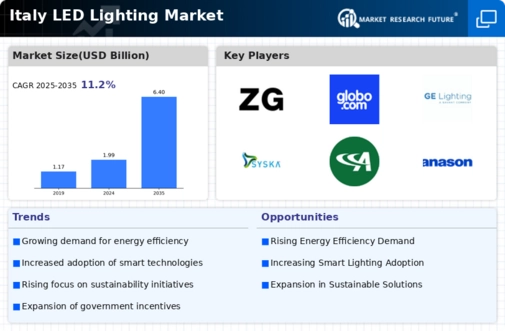Consumer Awareness and Education
There is a growing awareness among Italian consumers regarding the benefits of led lighting, which is positively influencing the market. Educational campaigns and information dissemination about energy savings, longevity, and environmental impact have led to a shift in consumer preferences. In 2025, surveys indicate that over 60% of consumers are aware of the advantages of led lighting compared to traditional options. This heightened awareness is likely to drive demand, as consumers increasingly seek out energy-efficient products. Retailers and manufacturers are responding by providing more information and promoting led lighting solutions, thereby enhancing market penetration and fostering a more informed consumer base.
Rising Demand for Smart Home Solutions
The increasing consumer interest in smart home technologies is driving growth in the led lighting market. In Italy, approximately 25% of households are now equipped with smart lighting systems, reflecting a shift towards integrated home automation. This trend is expected to expand as consumers seek convenience, energy savings, and enhanced control over their lighting environments. The integration of led lighting with smart home systems allows for remote management and energy monitoring, appealing to tech-savvy consumers. As the market evolves, manufacturers are likely to focus on developing innovative products that cater to this demand, potentially increasing the market share of led lighting solutions in the smart home sector.
Government Incentives for Energy Efficiency
The Italian government actively promotes energy efficiency through various incentives, which significantly impacts the led lighting market. Programs such as tax deductions and grants for energy-efficient upgrades encourage both residential and commercial sectors to transition to led lighting solutions. In 2025, it is estimated that approximately 30% of Italian households have benefited from these incentives, leading to a notable increase in led adoption. This trend is likely to continue as the government aims to meet its energy-saving targets, potentially reducing energy consumption by 20% by 2030. The led lighting market stands to gain from these initiatives, as they not only lower initial costs but also enhance the long-term economic viability of energy-efficient lighting solutions.
Urbanization and Infrastructure Development
Italy's ongoing urbanization and infrastructure development projects are contributing to the expansion of the led lighting market. As cities grow, there is a heightened need for efficient and sustainable lighting solutions in public spaces, roadways, and commercial buildings. In 2025, urban areas are projected to account for over 70% of the total energy consumption in Italy, prompting local governments to invest in led lighting to reduce energy costs and improve public safety. The shift towards led technology in urban planning not only enhances visibility but also aligns with sustainability goals. Consequently, the led lighting market is likely to experience robust growth as municipalities prioritize energy-efficient lighting in their development strategies.
Technological Advancements in Lighting Solutions
Technological advancements are playing a crucial role in shaping the led lighting market. Innovations in led technology, such as improved lumens per watt efficiency and enhanced color rendering, are making led solutions more appealing to consumers and businesses alike. In Italy, the market is witnessing a surge in the development of smart led products that offer features like tunable white light and connectivity options. These advancements not only improve the functionality of led lighting but also contribute to energy savings, with potential reductions in energy consumption by up to 50% compared to traditional lighting. As technology continues to evolve, the led lighting market is expected to expand, driven by the demand for more efficient and versatile lighting solutions.
























Leave a Comment